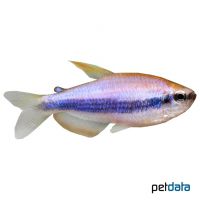Blue Purple Emperor Tetra (Inpaichthys kerri 'Blue')
| Blue Purple Emperor Tetra Inpaichthys kerri 'Blue' | |
|---|---|
| Name | Blue Purple Emperor Tetra |
| Name Lat. | Inpaichthys kerri 'Blue' |
| Family | Characins |
| Family lat. | Characidae |
| Order | Characins |
| Order lat. | Characiformes |
| Origin | Brazil (breeding variety) |
| Habitat | Tributaries, streams |
| Diet | Omnivore |
| pH | 5.5-7.0 |
| Behavior | Peaceful |
| Keeping | Group |
| Care Level | Moderate |
| Reproduction | Egg scatterer |
| Breeding | Difficult |
| Life Span | 2-4 years |
| Protection | No |
| Metric Units | |
| Size | 4 cm |
| Temperature | 23-27 °C |
| Hardness | 1-12 °dH |
| Aquarium | ~ 80 l |
| US Units | |
| Size | 1.6" |
| Temperature | 73-81 °F |
| Hardness | 18-214 ppm |
| Aquarium | ~ 20 gal |
Distribution and habitat
The Blue King Tetra is a breeding form. The natural range of the Blue King Tetra is tributaries of the Rio Aripuana in Brazil. They live in the brown, tannin-rich water of slow-flowing tributaries and streams of the rainforests.
Maintenance
The aquarium should have a varied, partly dense planting, with shelters and hiding places (roots) and provide sufficient swimming space. Soft, slightly acidic water, a dark substrate covered with some foliage (e.g. sea almond leaves), shaded light (floating plants) and a weak current is ideal.
No ammonia, ammonium and nitrite should be detectable, the nitrate value should not exceed 100 mg/l. To ensure the water quality and oxygen content, a filter and heater adapted to the aquarium size is required, as well as lighting for the species-appropriate day-night rhythm of the animals.
Diet
The food supply consists of live, frozen and dry food. For a balanced diet, feed once a day with a high-quality dry food (flakes, granules, pellets) as well as cyclops, daphnia, moina, mosquito larvae, artemia, etc. (live or frozen). In addition, they occasionally need some vegetable food, such as algae leaves, algae wafers or dry food with vegetable ingredients (e.g. spirulina). It is recommended to feed small portions several times a day, which are eaten within a few minutes. A regular and varied diet promotes health and increases resistance.
Behaviour and compatibility
They are peaceful and calm schooling fish that can be socialized well with other peaceful, not too lively fish. At least 5, but preferably more King Tetras should be kept together. They are considered fin twitchers. Kept in a group, other fish are rarely bothered and their occasionally quarrelsome behavior remains intraspecific.
In principle, only mutually compatible fish species with similar requirements for water conditions and water temperature should be socialized.
Sex dimorphism
The adipose fin in the male is pale blue, in the female red-orange.
Reproduction and breeding
In soft, slightly acidic peat water they usually spawn between fine-feathered plants. The larvae hatch after 24-48 hours and swim freely after 3-4 days. The parents do not engage in brood care and should be separated from the fry after spawning, as they are spawn predators.
Fry must be fed several times a day with special rearing food (Artemia nauplii). Breeding is hardly possible in community tanks, as the spawn is easy prey.
Important
Feeding with vegetable food reduces the risk of the fish eating the tender shoots of aquatic plants. When kept in hard water and improper care, king tetras remain pale and inconspicuous
The foliage (sea almond tree, oak, etc.) enriches the water with humic substances and naturally lowers the pH.
The well-being of the fish should be checked regularly. Temperature should be checked daily, pH, hardness and nitrate levels should be checked at least every 14 days. Regular partial water changes are recommended, even if the contaminant level has not yet reached the upper limit. Sudden changes in water quality should be avoided. Newly introduced fish must be accustomed slowly to the water in the aquarium.
Further literature can be found in your pet store.
References
Text: petdata; Image: petdata
Source: BMEL (1998): Tierschutzgutachten - Haltung von Zierfischen (Süßwasser); RIEHL & BAENSCH (2006): Aquarien Atlas Bd. 1, Mergus Verlag; ENGELMANN (2005): Zootierhaltung - Tiere in menschlicher Obhut: Fische, Verlag Harri Deutsch
- Gemäß § 21 Abs. 5 Tierschutzgesetz idgF
